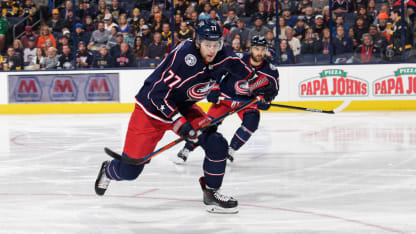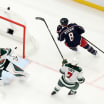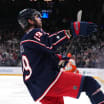This week, BlueJackets.com is taking a look at a few ways in which the game of hockey is changing right before our eyes. From a game that's getting faster by the second to one increasingly impacted by analytics off the ice, the NHL and the Blue Jackets are in the midst of an age of rapid transition. This week's stories will take a look at those trends across the league and how the Blue Jackets are staying at the forefront of all that is going on.
Josh Anderson is one of the fastest players in the NHL, possessing a speed burst that can make the big winger appear like a freight train trucking over the ice.
And yet, when asked in May how he wants to improve upon his game this summer, the Blue Jackets winger had a quick answer.
"Skating," he said. "I think you can get faster. You see how fast the game is now today."
The Changing NHL: Scoring, speed the new name of the game
As players become faster and more skilled, everyone has to keep up

© Jamie Sabau
For Markus Nutivaara, a puck-moving defenseman with the ability to glide across the ice with the best of them, the answer was the same.
"Work on my skating," he said. "The game is going so fast. I want to get faster and strong legs, be a good and fast skater."
They're certainly not wrong. What was once billed as the coolest game on earth now might very well be the fastest.
As rules have been implemented and then enforced that have taken away the ability of defensive players to clutch, grab and otherwise impede offensive players, speed and skill have never been accentuated quite like they are in today's game.
And as today's generation grows up encouraged to lean into that talent, a bevy of highly skilled young players have taken the ball and run with it. Fighting is down, goal scoring is up and the game is faster than it ever has been before.
"It's crazy," Blue Jackets captain Nick Foligno said. "You just think, 'How much faster can it get?' And every year it does. It's surprised me, and I think that's an area a lot of players are really focusing on now, especially as you get older. Guys are flying out there."
It's certainly a different game than it was 20 to 25 years ago. Take the New Jersey Devils as an example. When the team won the 1994-95 Stanley Cup, with a defensive style and a roster that could be described as hulking, all but seven contributors checked in above 6-feet tall and 19 players weighed at least 210 pounds. This past season, the Devils had 13 players who didn't reach the 6-foot mark, and just seven players were listed at 210 pounds or more.
According to
research done by Namita Nandakumar
, the average draft pick in 2018 was one inch shorter and 15 pounds lighter than in 2005. That 2018 draft was the one in which the Blue Jackets selected 5-foot-8 Swedish forward Marcus Karlberg in the third round and then in the seventh round circled back to take 5-foot-7 scoring dynamo Trey Fix-Wolansky of the WHL.
Considering the 5-foot-8 Cam Atkinson just scored 41 goals to tie the CBJ record for tallies in a season and is now second all-time in franchise annals in goals and points, it's fair to say the organization doesn't view small stature as an impediment - as long as the player can play and think the game at a high level.
"I know that the game is played fast," Kekalainen said. "It's not just the skating and the size part, it's getting faster and faster as far as the instincts and players processing the game at a faster pace. I think that's still the most important part of playing fast is how you think the game. But yeah, the NHL athlete is an incredible athlete in what they have to be able to do."
Just ask Foligno. A 12-year veteran of the league who broke in during the 2007 season and in many ways a throwback who isn't afraid to drop his mitts or throw his body around when need be, he's watched as the league has morphed over the years.
He'll turn 32 years old early in the 2019-20 season, and his offseason workout plans center around being able to perform in a league that's getting faster and faster.
"You're a good skater, but it's just that one step," he said. "It's amazing that the elite players in this league seem to have that ability to pull away from guys, and everyone else is right there underneath it. You have to be as fast as possible.
"I do a lot of speed stuff while in control of the puck (in training). You have to be able to make plays at that level, too. You can skate as fast as you want, but if you don't have the ability to hold on to the puck, you're not doing anything anyway."
So why has speed reached the point where it truly kills? It's a variety of factors, but one would certainly have to point to the elimination of much of the stick work that allowed defensive players to impede offensive players. That made obsolete some slow-footed defensemen, who simply couldn't keep up at that point, and evened the playing field for players of all sizes as long as they could play the game at a high level.
"You can't hook and hold and interfere like you were able to 15 years ago," Kekalainen said. "That is one thing that changed the game. The players are able to show their skill and get away from the checker because the checker can't hook. Fifteen, 20 years ago, if the defender put a hook on a guy, he's not going anywhere. Now, you're in the penalty box."
This past season, the average NHL team scored 3.01 goals per game, the highest total since 3.08 goals per game were scored per team in 2005-06. That was the year after the lockout canceled an entire campaign, and the league returned with a promise to open up the game.
But by 2015-16, teams were averaging 2.71 goals per game, and goaltenders saved shots at a .915 percent clip across the league. This past season, the save percentage number down was to .910, and the average of more than three goals per team was just the second time since 1996-97 that mark was reached.
The offensive boost has been led by a bevy of young standouts as well as smaller players who might not have been able to excel in previous versions of the NHL. Nine of the top 13 point scorers in the league last year were 25 years old or younger, and six -- Connor McDavid, Leon Draisaitl, Nathan MacKinnon, Aleksander Barkov, Mitch Marner and Brayden Point -- were 23 or younger.
When it comes to goal scoring, in a trend led by such smaller, skilled standouts as Alex DeBrincat and Johnny Gaudreau, seven of the 13 players to light the lamp at least 40 times check in at 5-foot-11 or shorter.
For that, Blue Jackets European development coach Jarkko Ruutu credits the training methods younger players have embraced, as many come into the league now possessing high-level abilities.
"I think overall the player skill level and the skating ability have taken big steps," Ruutu said. "It's the evolution of the game. You have to be able to keep up and adjust. The guys are very professional in a lot of ways when they come in young. They've been trained physically really well, they have skating coaches, skills coaches, this and that. I think that has changed a lot. But the overall player quality, it's the evolution. It's pretty scary how good the average guy is as a skater.
"It's from a young age. Young guys practice with a purpose, work on the details, and that's how you get better. And when that happens overall, with a lot of different players, that's how things elevate."
That doesn't mean the physical nature of the game is completely gone, as anyone who watched the Stanley Cup Playoffs -- in particular the series between Columbus and Boston -- can attest. This past season, a big St. Louis team -- all but four of the Blues checked in at 6-foot-0 or taller, and standouts Vladimir Tarasenko, Patrick Maroon and Colton Parayko all are listed at 225 or heavier -- won the ultimate prize when it lifted the Cup.
In the end, big, fast guys with skill will always be the ultimate chess pieces in the game, and the ability to handle the rigors of a physical two-month postseason will continue to be an important part of the sport.
But it's also a sport where speed and skill have taken off and show no signs of slowing down.
"It's become a very fast game, and it's entertaining," Ruutu said.
















